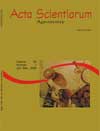<b>Application impact of maturate effluent of cassava industry on soil and sorghum culture (<em>Sorghum bicolor</em>)</b> - DOI: 10.4025/actasciagron.v26i4.1801
Abstract
The aim of this experiment was to evaluate the behavior of sorghum culture submitted to portions of maturate effluent of cassava industry. Thus, this study was carried out at Centro Técnico de Irrigação (Technical Irrigation Center) of Universidade Estadual de Maringá (State University of Maringá), state of Paraná, Brazil. Maturate effluent samples were collected from a lagoon, whose depth was not up to 0.50 m. Lysimeters of 1.0 m3 volume and 2.0 m2 area were applied to a sorghum culture. The utilized experimental design was composed of blocks at random in three treatments and six replications. The treatments were consisted of an application of: 150, 450 and 900 m3 ha-1 portions per year of mature effluent. The mature effluent from cassava industry supplied the nutritional necessities, which were required by sorghum for its entire development and production of green matter (or dry matter). A positive reply in growth, considering the entire process, in which the maximum portion added to sorghum culture was 450 m3 há-1, was verified. Otherwise, the elements of variable senescent leaves showed a negative correlation compared to others. A fertilizing effect of effluent was verified and analyzed according to the growth of the sorghum culture in relation to the macronutrients by potassium increaseDownloads
Download data is not yet available.
Published
2008-04-11
How to Cite
Silva, F. F. da, Freitas, P. S. L., Bertonha, A., Muniz, A. S., & Rezende, R. (2008). <b>Application impact of maturate effluent of cassava industry on soil and sorghum culture (<em>Sorghum bicolor</em>)</b> - DOI: 10.4025/actasciagron.v26i4.1801. Acta Scientiarum. Agronomy, 26(4), 421-427. https://doi.org/10.4025/actasciagron.v26i4.1801
Issue
Section
Agronomy
DECLARATION OF ORIGINALITY AND COPYRIGHTS
I Declare that current article is original and has not been submitted for publication, in part or in whole, to any other national or international journal.
The copyrights belong exclusively to the authors. Published content is licensed under Creative Commons Attribution 4.0 (CC BY 4.0) guidelines, which allows sharing (copy and distribution of the material in any medium or format) and adaptation (remix, transform, and build upon the material) for any purpose, even commercially, under the terms of attribution.
2.0
2019CiteScore
60th percentile
Powered by 

2.0
2019CiteScore
60th percentile
Powered by 



















































